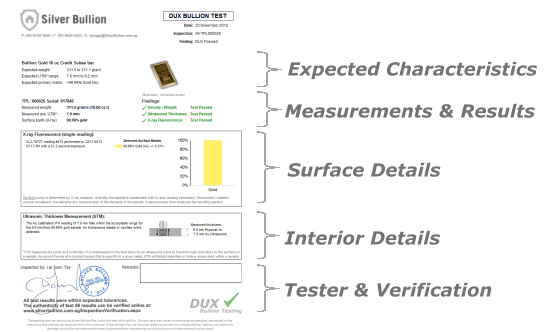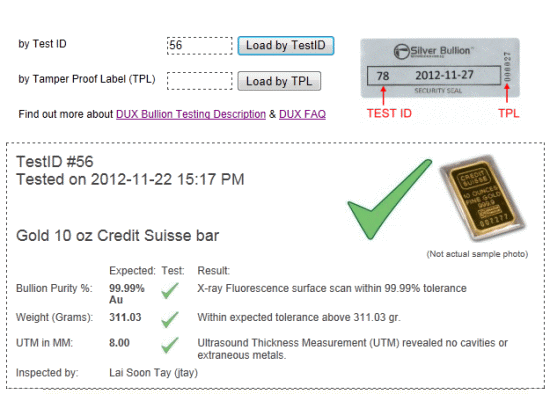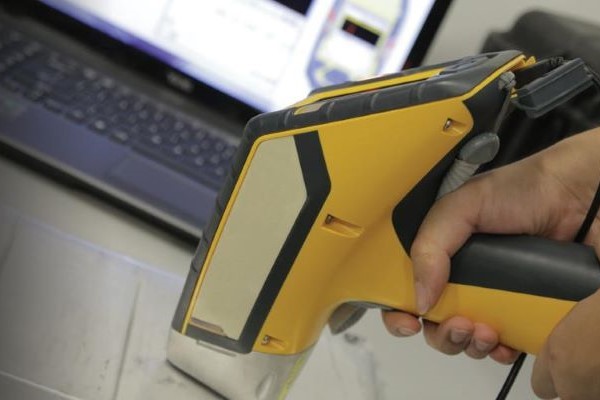DUX testing and the Genuinity Guarantee
When you purchase and store bullion with us, we guarantee that these bullion are genuine and are either purchased directly from the mint or fully tested using DUX.
In the unlikely event that the bullion purchased and/or stored with us turns out to be a fake, counterfeit, or of a significantly lower purity as stated in the product, we will provide a replacement of your bullion with the same type or if the type is unavailable, with a similar type of bullion with the same or better purity. See clause 5 Genuinity Guarantee in the Terms of Service for more details.
In this video, we share the basic principles of testing gold and silver to equip you with knowledge to avoid buying counterfeit bullion.
Our primary testing mechanism is DUX, a reliable non-destructive testing methodology, which we created in early 2012. Over one-million ounces of Bullion has been DUX tested and results can be retrieved online using a specific test ID or the associated parcel.
DUX is an acronym that stands for:
- Density
- Ultrasound
- X-ray Fluorescence
By combining three tests which measure different physical characteristics we achieve high testing reliability. Following are details:
Test 1 – “D” for Density
The first test we conduct on the coins and bars is Density / Mass. The analytical balances that we use are highly sensitive and require frequent calibration by approved vendors. The reason why we conduct this test first is because most fake bullion out in the market deviate from the genuine ones by mass. Through precision weighing, we can quickly and reliably screen out 95% of the fakes that are out there in the market.
Investment Grade bullion should be within a small range above its stated mass. This is because during the production process, the mint must compensate for trace amounts of impurities present by giving small amounts (at least a few milligrams) of extra metal. This will ensure that the minimum given metal is always provided for.
It is also possible for genuine bullion to be slightly below its stated mass due to excessive polishing or scratching which can result in very small mass loss. This is very rare however.
Test 2 – “U” for Ultrasound
Despite precision mass measurement, test results can be misled by high-quality fakes made of advanced composite bars and alloys. These high-quality fakes can have masses that measure exactly the same as genuine bullion items. However, metals with similar densities can exhibit very different ultrasonic properties, therefore making ultrasonics an excellent complement to the density test. By complementing precision weighing and Ultrasonic Thickness Measurement (UTM), it is extremely difficult for a fake bar to pass both tests.
Ultrasonics tests measure a whole range of properties. The property that we focus on is called “Celerity”. Celerity is the velocity at which sound waves travel through the metal. The Celerity of every element is characteristic to that element and can vary greatly:
- Silver: 3,650 meters / second
- Gold: 3,240 meters / second
- Tungsten: 5,174 meters / second (approx. 38% different from gold)
- Platinum: 3,260 meters / second
For example, a typical 10 oz Credit Suisse gold bar that is 8mm in thickness would give a reading of approximately 8mm in an ultrasonics measurement. If it was a gold-plated tungsten bar, the ultrasonics measurement would read only 5.0 mm. This is because sound waves travel at a much faster velocity (see above) through tungsten therefore resulting in a much lower reading. UTM can also be used to detect hollow areas inside the bar.

Test 3 – “X” for X-Ray
X-Ray Fluorescence Spectrometry, or XRF in short, is a technology used to quickly and reliably identify the metals present in a sample as well as measure its purity. Results can be obtained reliably within 20 seconds of testing with up to 0.01% accuracy.
In an XRF Spectrometry test, the metal is being exposed to broad-sprectrum X-Rays emitted by the spectrometer. The metal will then interact with the X-Rays and emit X-Rays of characteristic wavelengths/energies. The detector present in the spectrometer will analyse these X-Rays and provide the detailed composition of the metal sample.
Although extremely powerful in detecting surface compositions, it is important to note that XRF spectrometry is a surface composition analysis. It cannot penetrate beyond the immediate subsurface (~20 microns). Having said that, the test can still be used to detect gold plating but not strong enough to detect advanced hollowed out gold bars.
Because XRF Spectrometry is merely analyses the metal surface, it not enough to reliably test bullion, but in conjunction with UTM and Density Tests this combined DUX tri-standard is very reliable and is industry leading in non-invasive bullion testing.
Below is a snapshot of “X-Ray fluorescence Details” section found in our DUX test report. The reading below shows such a test on gold-plated tungsten bar. High nickel content on the surface is common for gold-plated tungsten bars.

Putting it all together - The DUX Bullion Testing System
A test is reliable when it is performed in accordance to very strict standard operating procedures. These procedures are enforced by custom software that interfaces directly with our testing instruments, giving traceability and minimises human error in the test results.
Readings obtained from the testing instruments will be verified against an online database of parameters that are unique to different products. Through verification, we can conclude whether the item passed or failed the bullion test. Below is a sample test report:

Aside from printed test reports, the DUX test results can also be retrieved online.

To identify and mark the tested bullion we offer our clients the option to use our uniquely ID Tamper Proof Labels (TPLs) to link the tested bullion item with their respective online test results.
If you have any questions pertaining to our testing service or wish to have your bullion tested, you may schedule an appointment with us at [email protected], call us at +65 6100-3040 or read the DUX Testing FAQ.

